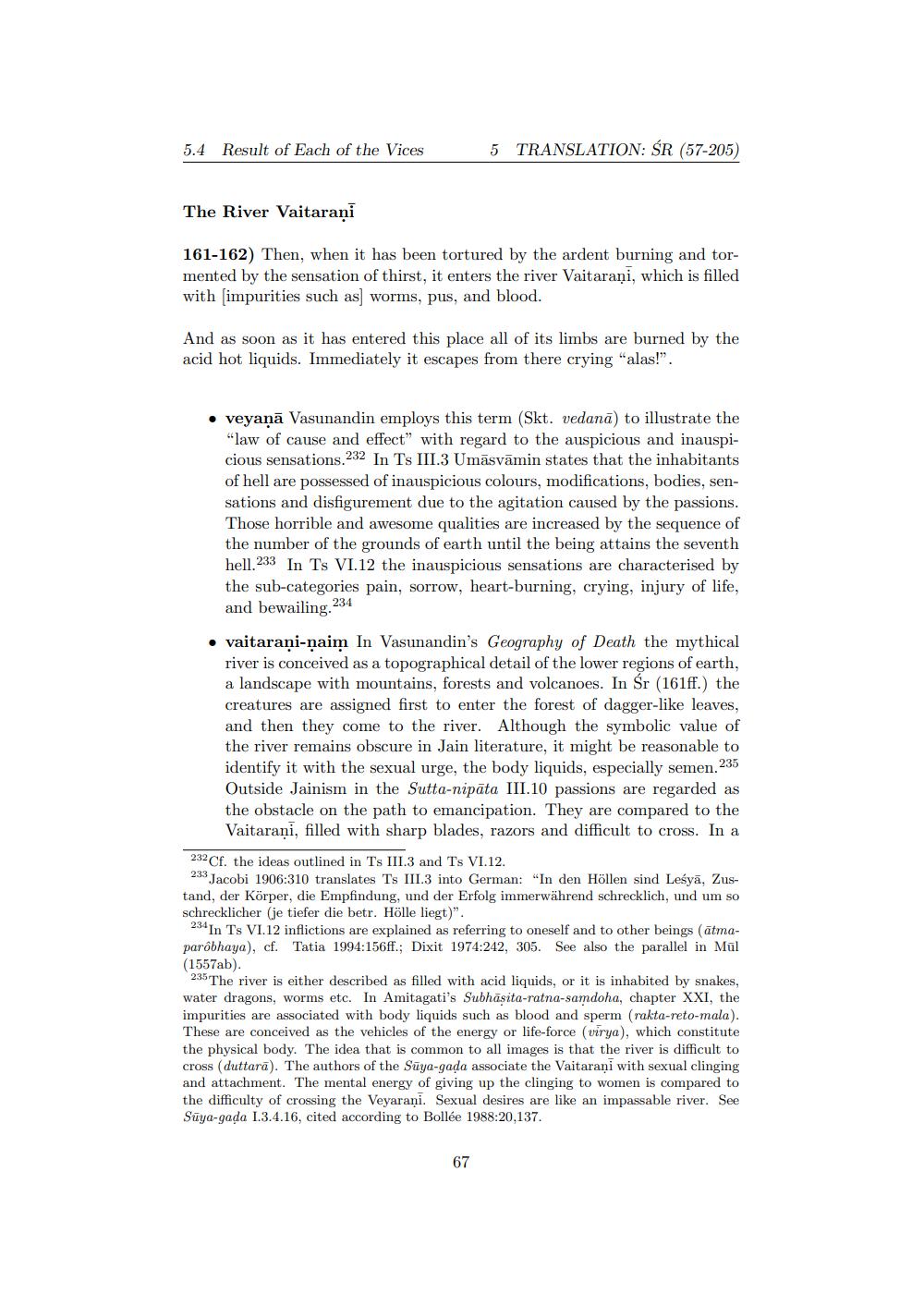________________
5.4 Result of Each of the Vices
5
TRANSLATION: SR (57-205)
The River Vaitarani
161-162) Then, when it has been tortured by the ardent burning and tormented by the sensation of thirst, it enters the river Vaitaraņi, which is filled with impurities such as worms, pus, and blood.
And as soon as it has entered this place all of its limbs are burned by the acid hot liquids. Immediately it escapes from there crying "alas!".
• veyaņā Vasunandin employs this term (Skt. vedana) to illustrate the
"law of cause and effect" with regard to the auspicious and inauspicious sensations. 232 In Ts III.3 Umāsvāmin states that the inhabitants of hell are possessed of inauspicious colours, modifications, bodies, sensations and disfigurement due to the agitation caused by the passions. Those horrible and awesome qualities are increased by the sequence of the number of the grounds of earth until the being attains the seventh hell. 233 In Ts VI.12 the inauspicious sensations are characterised by the sub-categories pain, sorrow, heart-burning, crying, injury of life, and bewailing 234
vaitaraņi-naim In Vasunandin's Geography of Death the mythical river is conceived as a topographical detail of the lower regions of earth, a landscape with mountains, forests and volcanoes. In Sr (161ff.) the creatures are assigned first to enter the forest of dagger-like leaves, and then they come to the river. Although the symbolic value of the river remains obscure in Jain literature, it might be reasonable to identify it with the sexual urge, the body liquids, especially semen.235 Outside Jainism in the Sutta-nipāta III.10 passions are regarded as the obstacle on the path to emancipation. They are compared to the Vaitarani, filled with sharp blades, razors and difficult to cross. In a
232 Cf. the ideas outlined in Ts III.3 and TS VI.12. 233 Jacobi 1906:310 translates Ts III.3 into German: "In den Höllen sind Leśyā, Zustand, der Körper, die Empfindung, und der Erfolg immerwährend schrecklich, und um so schrecklicher (je tiefer die betr. Hölle liegt)".
234 In Ts VI.12 inflictions are explained as referring to oneself and to other beings (ātmaparôbhaya), cf. Tatia 1994:156ff.; Dixit 1974:242, 305. See also the parallel in Mül (1557ab).
235 The river is either described as filled with acid liquids, or it is inhabited by snakes, water dragons, worms etc. In Amitagati's Subhāsita-ratna-samdoha, chapter XXI, the impurities are associated with body liquids such as blood and sperm (rakta-reto-mala). These are conceived as the vehicles of the energy or life-force (virya), which constitute the physical body. The idea that is common to all images is that the river is difficult to cross (duttarā). The authors of the Süya-gada associate the Vaitarani with sexual clinging and attachment. The mental energy of giving up the clinging to women is compared to the difficulty of crossing the Veyarani. Sexual desires are like an impassable river. See Süya-gada 1.3.4.16, cited according to Bollée 1988:20,137.
67




